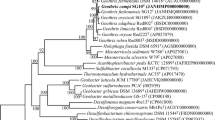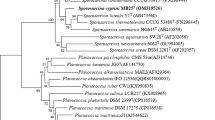Abstract
Odor caused by the presence of geosmin and 2-methylisoborneol (2-MIB) in aquatic ecosystems leads to considerable economic loss worldwide. The odorous compounds are primarily produced by cyanobacteria and actinomycetes. While the contribution of odorous compounds-producing cyanobacteria has been thoroughly investigated, the production of geosmin and 2-MIB by actinomycetes in aquatic ecosystems is poorly understood. In this study, we isolated geosmin and/or 2-MIB-producing actinomycetes in sediments collected from the Sanbe Reservoir, Japan, identified the biosynthetic gene of geosmin and 2-MIB, and investigated the production of the odorous compounds by the isolated strains. Partial sequence of 16S rRNA and the biosynthetic genes was determined to analyze the phylogenetic relationship among the strains. The geosmin and 2-MIB concentrations in the culture of the isolated strains were measured using gas chromatography mass spectrometry. Fifty-four strains of odorous compounds-producing and non-geosmin-producing actinomycetes were isolated from sediments from the Sanbe Reservoir. Diverse actinomycetes were identified and many of them produced geosmin and/or 2-MIB. Many odorous compounds-producing actinomycetes were phylogenetically different from previously reported producing actinomycetes. The producing ability of the odorous compounds of the isolated strains in this study was not significantly related with the phylogenetic groups of 16S rRNA and the biosynthetic genes. The findings suggest that the odorous compounds-producing actinomycetes in the sediments are diverse and different from previously reported strains.






Similar content being viewed by others
References
Gerber NN, Lecheval HA (1965) Geosmin an Earthy-Smelling Substance Isolated from Actinomycetes. Appl Microbiol 13(6):935–938. https://doi.org/10.1128/Aem.13.6.935-938.1965
Medsker LL, Jenkins D, Thomas JF, Koch C (1969) Odorous compounds in natural waters. 2-Exo-hydroxy-2-methylbornane major odorous compound produced by several actinomycetes. Environ Sci Technol 3(5):476–477. https://doi.org/10.1021/es60028a008
Robin J, Cravedi JP, Hillenweck A, Deshayes C, Vallod D (2006) Off flavor characterization and origin in French trout farming. Aquaculture 260(1–4):128–138. https://doi.org/10.1016/j.aquaculture.2006.05.058
Devi A, Chiu YT, Hsueh HT, Lin TF (2021) Quantitative PCR based detection system for cyanobacterial geosmin/2-methylisoborneol (2-MIB) events in drinking water sources: current status and challenges. Water Res 188:116478. https://doi.org/10.1016/j.watres.2020.116478
Watson SB, Monis P, Baker P, Giglio S (2016) Biochemistry and genetics of taste- and odor-producing cyanobacteria. Harmful Algae 54:112–127. https://doi.org/10.1016/j.hal.2015.11.008
Liato V, Aider M (2017) Geosmin as a source of the earthy-musty smell in fruits, vegetables and water: origins, impact on foods and water, and review of the removing techniques. Chemosphere 181:9–18. https://doi.org/10.1016/j.chemosphere.2017.04.039
Zaitlin B, Watson SB (2006) Actinomycetes in relation to taste and odour in drinking water: myths, tenets and truths. Water Res 40(9):1741–1753. https://doi.org/10.1016/j.watres.2006.02.024
Jüttner F, Watson SB (2007) Biochemical and ecological control of geosmin and 2-methylisoborneol in source waters. Appl Environ Microbiol 73(14):4395–4406. https://doi.org/10.1128/AEM.02250-06
Callejon RM, Ubeda C, Rios-Reina R, Morales ML, Troncoso AM (2016) Recent developments in the analysis of musty odour compounds in water and wine: a review. J Chromatogr A 1428:72–85. https://doi.org/10.1016/j.chroma.2015.09.008
Sugiura N, Nakano K (2000) Causative microorganisms for musty odor occurrence in the eutrophic Lake Kasumigaura. Hydrobiologia 434(1–3):145–150. https://doi.org/10.1023/A:1004000511610
Kikuchi T, Kadota S, Suehara H, Nishi A, Tsubaki K, Yano H, Harimaya K (1983) Odorous metabolites of fungi, Chaetomium globosum KINZE ex FR. and Botrytis cinerea PERS. ex FR., and a blue-green alga, Phormidium tenue (MENEGHINI) GOMONT. Chem Pharm Bull (Tokyo) 31(2):659–663
Trowitzsch W, Witte L, Reichenbach H (1981) Geosmin from earthy smelling cultures of Nannocystis exedens (Myxobacterales). FEMS Microbiol Lett 12(3):257–260
Anuar NSS, Kassim AA, Utsumi M, Iwamoto K, Goto M, Shimizu K, Othman N, Zakaria Z, Sugiura N, Hara H (2017) Characterization of musty odor-producing actinomycetes from tropics and effects of temperature on the production of musty odor compounds. Microbes Environ 32(4):352–357. https://doi.org/10.1264/jsme2.ME17109
Asquith E, Evans C, Dunstan RH, Geary P, Cole B (2018) Distribution, abundance and activity of geosmin and 2-methylisoborneol-producing Streptomyces in drinking water reservoirs. Water Res 145:30–38. https://doi.org/10.1016/j.watres.2018.08.014
Klausen C, Nicolaisen MH, Strobel BW, Warnecke F, Nielsen JL, Jorgensen NO (2005) Abundance of actinobacteria and production of geosmin and 2-methylisoborneol in Danish streams and fish ponds. FEMS Microbiol Ecol 52(2):265–278. https://doi.org/10.1016/j.femsec.2004.11.015
Zuo Y, Li L, Zhang T, Zheng L, Dai G, Liu L, Song L (2010) Contribution of Streptomyces in sediment to earthy odor in the overlying water in Xionghe Reservoir, China. Water Res 44(20):6085–6094. https://doi.org/10.1016/j.watres.2010.08.001
Tung SC, Lin TF, Tseng IC, Lin HM (2006) Identification of 2-MIB and geosmin producers in Feng-Shen reservoir in south Taiwan. Water Sci Technol-Water Supply 6(2):55–61. https://doi.org/10.2166/ws.2006.050
Zuo YX, Li L, Wu ZX, Song LR (2009) Isolation, identification and odour-producing abilities of geosmin/2-MIB in actinomycetes from sediments in Lake Lotus, China. J Water Supply Res Technol 58(8):552–561. https://doi.org/10.2166/aqua.2009.018
Park TJ, Yu MN, Kim HS, Cho HS, Hwang MY, Yang HJ, Lee JC, Lee JK, Kim SJ (2016) Characteristics of actinomycetes producing geosmin in Paldang Lake, Korea. Desalin Water Treat 57(2):888–899. https://doi.org/10.1080/19443994.2014.970583
Godo T, Saki Y, Nojiri Y, Tsujitani M, Sugahara S, Hayashi S, Kamiya H, Ohtani S, Seike Y (2017) Geosmin-producing species of Coelosphaerium (Synechococcales, Cyanobacteria) in Lake Shinji, Japan. Sci Rep 7:41928. https://doi.org/10.1038/srep41928
Kim K, Park C, Yoon Y, Hwang SJ (2018) Harmful cyanobacterial material production in the North Han River (South Korea): genetic potential and temperature-dependent properties. Int J Env Res Public Health 15(3):444. https://doi.org/10.3390/ijerph15030444
Churro C, Semedo-Aguiar AP, Silva AD, Pereira-Leal JB, Leite RB (2020) A novel cyanobacterial geosmin producer, revising GeoA distribution and dispersion patterns in Bacteria. Sci Rep 10(1):8679. https://doi.org/10.1038/s41598-020-64774-y
Hayashi S, Ohtani S, Godo T, Nojiri Y, Saki Y, Esumi T, Kamiya H (2019) Identification of geosmin biosynthetic gene in geosmin-producing colonial cyanobacteria Coelosphaerium sp. and isolation of geosmin non-producing Coelosphaerium sp. from brackish Lake Shinji in Japan. Harmful Algae 84:19–26. https://doi.org/10.1016/j.hal.2019.01.010
Kutovaya OA, Watson SB (2014) Development and application of a molecular assay to detect and monitor geosmin-producing cyanobacteria and actinomycetes in the Great Lakes. J Great Lakes Res 40(2):404–414. https://doi.org/10.1016/j.jglr.2014.03.016
Jorgensen NOG, Podduturi R, Burford MA (2016) Relations between abundance of potential geosmin- and 2-MIB-producing organisms and concentrations of these compounds in water from three Australian reservoirs. J Water Supply Res Technol 65(6):504–513. https://doi.org/10.2166/aqua.2016.001
Kim S, Hayashi S, Masuki S, Ayukawa K, Ohtani S, Seike Y (2021) Effect of rainfall and pH on musty odor produced in the Sanbe reservoir. Water 13(24):3600. https://doi.org/10.3390/w13243600
Sugihara K, Takada K, Yamashita S (2005) Modeling of musty odor caused by actinomycetes in dam reservoir. Mon. Rep Civ Eng Res Inst 630:10–22 (in Japanese)
Otoguro M, Nakashima T, Miyadoh S (2012) Isolation of actinomycetes and search of antibiotics. Seibutsu-kogaku kaishi 90(8):493–498 (in Japanese)
Weisburg WG, Barns SM, Pelletier DA, Lane DJ (1991) 16S ribosomal DNA amplification for phylogenetic study. J Bacteriol 173(2):697–703
Huong NL, Itoh K, Suyama K (2007) Diversity of 2,4-dichlorophenoxyacetic acid (2,4-D) and 2,4,5-trichlorophenoxyacetic acid (2,4,5-T)-degrading bacteria in Vietnamese soils. Microbes Environ 22(3):243–256. https://doi.org/10.1264/jsme2.22.243
Du H, Lu H, Xu Y, Du X (2013) Community of environmental streptomyces related to geosmin development in Chinese liquors. J Agric Food Chem 61(6):1343–1348. https://doi.org/10.1021/jf3040513
Kumar S, Stecher G, Tamura K (2016) MEGA7: Molecular evolutionary genetics analysis version 7.0 for bigger datasets. Mol Biol Evol 33:1870–1874
Cane DE, Ikeda H (2012) Exploration and mining of the bacterial terpenome. Acc Chem Res 45(3):463–472. https://doi.org/10.1021/ar200198d
Auffret M, Pilote A, Proulx E, Proulx D, Vandenberg G, Villemur R (2011) Establishment of a real-time PCR method for quantification of geosmin-producing Streptomyces spp. in recirculating aquaculture systems. Water Res 45(20):6753–6762. https://doi.org/10.1016/j.watres.2011.10.020
Schrader KK, Summerfelt ST (2010) Distribution of off-favor compounds and isolation of geosmin-producing bacteria in a series of water recirculating systems for rainbow trout culture. N Am J Aquacult 72(1):1–9. https://doi.org/10.1577/A09-009.1
Rezanka T, Prell A, Sigler K (2008) Identification of odorous compounds from nine fermentor-cultivated Streptomyces strains. Folia Microbiol 53(4):315–318. https://doi.org/10.1007/s12223-008-0049-3
Ichikawa N, Oguchi A, Ikeda H, Ishikawa J, Kitani S, Watanabe Y, Nakamura S, Katano Y, Kishi E, Sasagawa M, Ankai A, Fukui S, Hashimoto Y, Kamata S, Otoguro M, Tanikawa S, Nihira T, Horinouchi S, Ohnishi Y, Hayakawa M, Kuzuyama T, Arisawa A, Nomoto F, Miura H, Takahashi Y, Fujita N (2010) Genome sequence of Kitasatospora setae NBRC 14216T: an evolutionary snapshot of the family Streptomycetaceae. DNA Res 17(6):393–406. https://doi.org/10.1093/dnares/dsq026
Omura S, Takahashi Y, Iwai Y, Tanaka H (1982) Kitasatosporia, a new genus of the order Actinomycetales. J Antibiot 35(8):1013–1019. https://doi.org/10.7164/antibiotics.35.1013
Schrader KK, Harries MD, Page PN (2015) Temperature effects on biomass, geosmin, and 2-methylisoborneol production and cellular activity by Nocardia spp. and Streptomyces spp. isolated from rainbow trout recirculating aquaculture systems. J Ind Microbiol Biotechnol 42(5):759–767. https://doi.org/10.1007/s10295-015-1600-2
Cane DE, He XF, Kobayashi S, Omura S, Ikeda H (2006) Geosmin biosynthesis in Streptomyces avermitilis. Molecular cloning, expression, and mechanistic study of the germacradienol/geosmin synthase. J Antibiot 59(8):471–479
Jiang J, Cane DE (2008) Geosmin biosynthesis. Mechanism of the fragmentation-rearrangement in the conversion of germacradienol to geosmin. J Am Chem Soc 130(2):428–429. https://doi.org/10.1021/ja077792i
Jiang J, He X, Cane DE (2007) Biosynthesis of the earthy odorant geosmin by a bifunctional Streptomyces coelicolor enzyme. Nat Chem Biol 3(11):711–715. https://doi.org/10.1038/nchembio.2007.29
Jiang J, He X, Cane DE (2006) Geosmin biosynthesis. Streptomyces coelicolor germacradienol/germacrene D synthase converts farnesyl diphosphate to geosmin. J Am Chem Soc 128(25):8128–8129. https://doi.org/10.1021/ja062669x
Xu J, Wang Y, Xie SJ, Xu J, Xiao J, Ruan JS (2009) Streptomyces xiamenensis sp. Nov., isolated from mangrove sediment. J Syst Evol Microbiol 59(3):472–476. https://doi.org/10.1099/ijs.0.000497-0
Peng C, Yan X, Wang X, Huang Y, Jiang L, Yuan P, Wu X (2020) Release of odorants from sediments of the largest drinking water reservoir in Shanghai: influence of pH, temperature, and hydraulic disturbance. Chemosphere 265:129068. https://doi.org/10.1016/j.chemosphere.2020.129068
Acknowledgements
This work was supported as commissioned research from Shimane prefecture (2017–2019). The authors would like to thank the Shimane prefecture kenou prefectural land maintenance office for providing information about odorous compounds in the Sanbe Reservoir. The authors thank the faculty of Life and Environmental Science at Shimane University for their financial support for the publication of this report. The authors would like to thank Editage (www.editage.jp) for English language editing.
Funding
This research was financially supported by Shimane prefecture.
Author information
Authors and Affiliations
Contributions
SH, SM, SK and YS designed the project and wrote the manuscript. SH designed and performed the isolation and genetic analysis. SH and SM collected water and sediment samples. KF and DS contributed to the analysis of geosmin and 2-MIB. All authors reviewed and approved the final manuscript.
Corresponding author
Ethics declarations
Conflict of interest
The authors declare that they have no competing interests.
Ethical Approval
Not applicable.
Consent for Publication
Not applicable.
Consent to Participate
Not applicable.
Additional information
Publisher's Note
Springer Nature remains neutral with regard to jurisdictional claims in published maps and institutional affiliations.
Supplementary Information
Below is the link to the electronic supplementary material.
Rights and permissions
Springer Nature or its licensor holds exclusive rights to this article under a publishing agreement with the author(s) or other rightsholder(s); author self-archiving of the accepted manuscript version of this article is solely governed by the terms of such publishing agreement and applicable law.
About this article
Cite this article
Hayashi, S., Masuki, S., Furuta, K. et al. Phylogenetic Analysis and Characterization of Odorous Compound-Producing Actinomycetes in Sediments in the Sanbe Reservoir, A Drinking Water Reservoir in Japan. Curr Microbiol 79, 344 (2022). https://doi.org/10.1007/s00284-022-03052-8
Received:
Accepted:
Published:
DOI: https://doi.org/10.1007/s00284-022-03052-8




